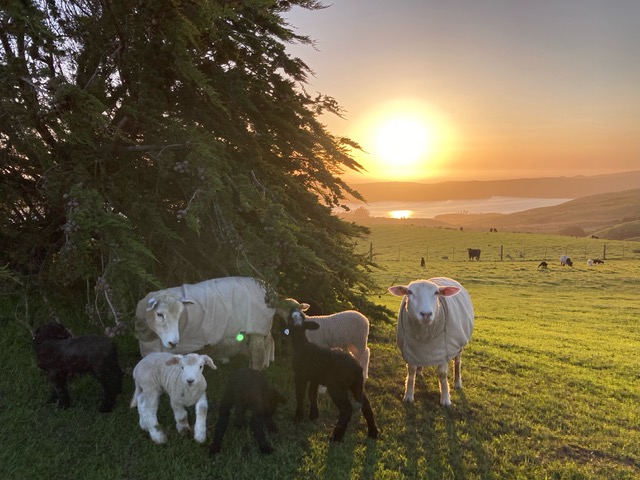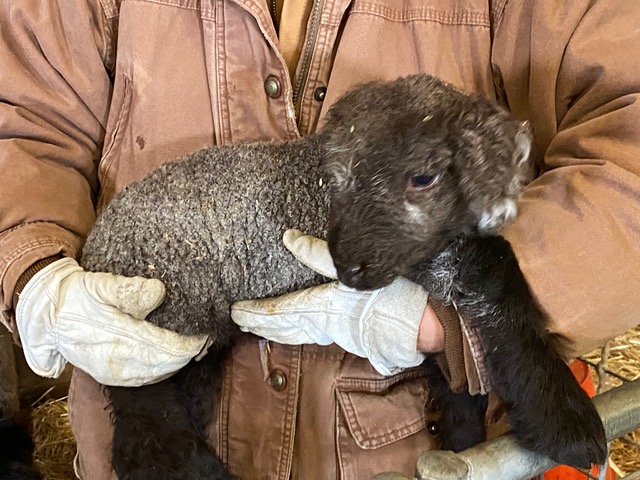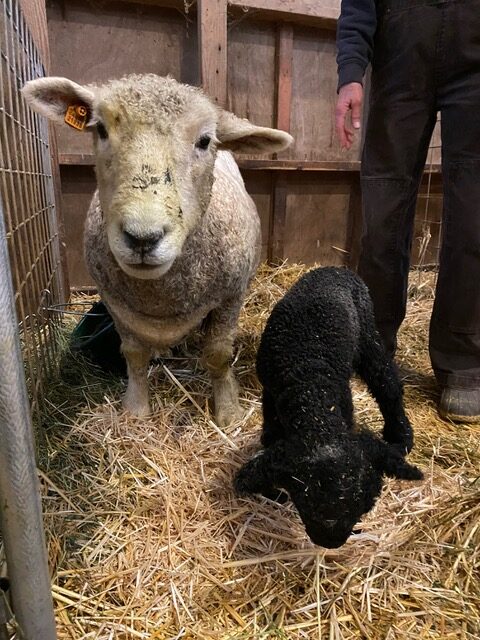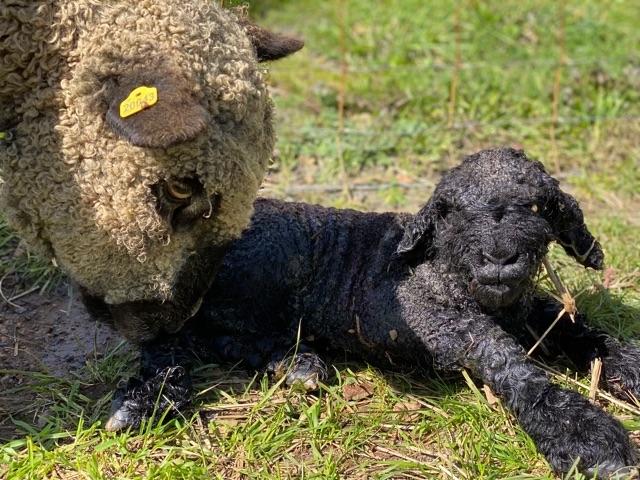
We have been lambing for a full month now (our first lambs were born February 16th) and most of that time we have been deluged with one atmospheric river after another, and really cold temperatures also. Finally we have a few days of warm sunshine, although another storm is due this weekend. And, with only 3 ewes left, the end of lambing is in sight.
Despite the awful weather, it has been a remarkably good season so far. We have only lost two lambs, one still-born and one neonatal death, from watery mouth, an E. coli infection that is directly the result of a lamb not getting enough passive immunity from its mother’s colostrum. We understand how this one happened, and it is an important reminder of how crucial those first sips of colostrum are for every lamb.
We had one triplet rejected by his mother; he is being raised as a bottle-lamb. But aside from those, all our lambs are healthy and being raised by their mothers, and all the ewes are healthy. We have 73 lambs from 41 ewes at this point, and 3 ewes left to lamb.
This year was the beginning of our Romney Moorit-breeding program. Moorits are brown sheep, whose color comes from a recessive mutation that causes oxidation of the melanin pigment from black to brown. It is quite rare in Romney sheep. Last year we acquired two Moorit Romney rams from Maggie and Carol at Tawanda Farms, who started a Moorit-breeding program a few years ago. Their founding sire was named Balthazar (a Moor bearing gifts), and we got two Moorit rams from them, named Panama and Cordoba, and a couple of Moorit-carrier ewes. We bred Panama and Cordoba to some of our recessive-colored Romney ewes to produce Moorit-carriers, and bred them to the Moorit-carrier ewes we got from Maggie and Carol to try for some Moorits. Out of those crosses we got two Moorit ram-lambs, the fellow on the left below, a son of Cordoba who we named Alhambra, and on the right this flashy son of Panama, born last night, who we named Morgan, for Morgan Freeman, who played the Moor in Robin Hood, Prince of Thieves. They are a beautiful mahogany color, so much fun to see, and we are looking forward to beautiful fleeces and natural colored yarns from them and their future offspring!


Most of our ewes have lambed alone this season and we are relieved to have had so many fewer births requiring intervention than in the old dairy days with the East Friesians. And most of our ewes have had twins or singles, with only 3 sets of triplets, another welcome change from the dairy days. Still, despite the easier lambing, we are always on alert for those times when a ewe does need help and can’t do it alone. The past 4 days tell the story of both extremes.
Monday my cousin Linda left for home after spending two weeks lambing with us, and we all were sad that she had gone. In the late afternoon, Heidi, a small white Romney and first-time mother, was in labor, and Lisa and I had been watching her for a couple of hours. Finally, when she wasn’t progressing, I became concerned and investigated. I found one front foot and the head, but the second foot was not there. A ewe can’t generally deliver a lamb unassisted with one foot back, but although the books all tell you that you need to put it back in the uterus and get the second leg, we have pulled many lambs with one foot back. I started to pull the lamb, but it was BIG. What’s more, the other foot wasn’t just back, the leg was bent, and I could feel the knee in the birth canal. Everything had to go back in, so I scrubbed up, cleaned Heidi up, and began pushing whenever she took a break in her contractions. It took all the strength I had. I HATE having to intervene like this–it was almost a daily occurrence with the dairy sheep and I’m so glad it is so much more rare now. Lisa held Heidi’s head and whispered comfort to her, while I pushed that lamb back in and got the other foot. Then it was a very hard pull. That lamb’s head and chest completely filled the space within Heidi’s pelvis. All I could think of was a few years ago when a shepherd friend of mine had a preternaturally huge lamb that she simply could not get out. She wound up having to shoot the ewe to end her suffering. Heidi’s was a happy ending, however, and we got that lamb out. It was a 17.25 pound boy! I think it might be the biggest lamb we have ever had. Heidi bounced back immediately and loved that lamb. I was amazed she wasn’t more shocky. We gave her a shot of antibiotic to protect against uterine infection. Lisa named the boy “Angus,” because he seemed more like a steer than a lamb!

I wake myself up in the middle of the night every night during lambing to check the barn camera, and I go up to the barn if there are signs of a ewe in labor, or if there are lambs recently born in the barn, just to be sure that they get their first sips of colostrum, get their navels dipped, and get safely into a jug with their mother. After a month of this, the exhaustion is taking its toll. Yesterday was Lisa’s day off, so I had the full responsibility of evening barn duty as well, and I was feeling dead tired. The pregnant ewes were in a small pasture near the barn and all seemed quiet, no signs of labor. I set up all the feed in the lambing barn for the remaining pregnant ewes, set up the other barn for the group of ewes and young lambs who would be coming in for the night, and went home for a bit to rest, thinking I’d leave the sheep out as long as possible to enjoy the last hours of the first sunny day they have seen in a while.
At 7:00, I went to the barn, figuring I’d feed Skeezix, the bottle lamb, and let the groups in, and all that should only take a few minutes. As I was making Skeezix’s bottle, I looked out and saw Clara on the hillside, licking a newborn lamb, with another halfway born. Now I had a LOT to do before sunset, and it was a bit of a scramble, but I got Clara and her lambs situated, umbilicals dipped in iodine to prevent navel infection, and first drinks of colostrum to give them the immunity they need. Got Skeezix fed, got the ewes and lambs into their barn and the expectant mothers into theirs, verified that the rest of them looked quiet and not in labor, and went home for dinner. After dinner, it was all I could do to stay awake until 10:00 when Skeezix needed his last feeding of the night. I went up, expecting to be there 5 minutes, and found Aulait showing signs of labor, and Casita, a first-time mother, with a broken water bag.
Ugh. I knew it might be hours before they delivered, and I was too exhausted to face hours in the barn. I convinced myself that “nothing bad can happen in two hours,” because usually we allow a ewe to labor at least a few hours before we judge her to not be progressing normally and begin to intervene. So I went home to catch a few hours of sleep.
I woke myself at midnight, looked at the barn camera and there was Casita licking off a huge lamb, and Aulait with a lamb as well! I dragged myself up and back to the barn, but my work was quick, just dipping and sipping two lambs and settling them with their mothers in new jugs. Aulait is one of our Moorit-carriers and I couldn’t tell in the dimly-lit barn, but her lamb looked like a Moorit and turned out he is. Casita’s is a Moorit-carrier ewe, so hopefully a future mother of Moorits.

So it would seem that most of the time we humans can go take a nap and the ewes will have their lambs all on their own. It is always good to be on hand to get that umbilical dipped and make sure the lamb has a good drink, but in general nature takes its course on its own. Except when it doesn’t, as happened this afternoon.
Brownie, our little recessive-colored Romney ewe whose fleece won Grand Champion Handspinner fleece at the California National Wool Show in September, had never lambed, and late this morning she was pawing in the pasture, trying to “make a nest” and showing other signs of early labor. I went home to do some office work, and at 12:30 before having lunch, decided to go up to check on Brownie. She was in the pasture in hard labor, but not showing any signs of a lamb. I got the lambing kit and waited with her. And waited and waited. Two hours of hard labor. She was exhausted, staring me in the eyes and panting, moaning, straining. There was nothing to do but wait for her to progress. Pretty soon I saw a foot, and it was a HUGE foot! I did a little investigating and there was another foot, and behind that, a snout, and a mouth with the tongue already lolling out of the mouth. Another huge lamb. The lamb was in the proper position and Brownie just had to labor some more, but it was so difficult to see her strain. Melinda was on the ranch, but needed to leave at 2:00, and Lolo was taking his dad to a doctors appointment, but due back at 2:00. I texted Lolo and he said he was on his way home. Finally I decided I had to pull that lamb, and began struggling to get a grip on the slippery feet. Lolo arrived and came running up the pasture just as I was pulling with all my strength. He helped, and we got that lamb out. Brownie was exhausted, but like Heidi a few days ago, she didn’t go shocky and just started loving her giant lamb. This one was a 16 lb boy.
Lisa arrived for her shift, I told her all that had happened, we admired our handsome Moorit boy and all the other lambs, and she got busy with the evening chores. I headed home, looking forward to dinner, and an early night.


A few hours ago, just as I began writing this, Lisa called to tell me she found Poppy in the pasture with a lamb, and was bringing her into the barn.
Then she called back to tell me Gladys had a mucous string (a sign of imminent labor) and was making a nest in the barn. I thought of ending this post with: “We could go to bed and let nature take its course. Or be on hand, just in case.”
But before I had that written, Lisa called back. Gladys had delivered one lamb and another was on the way, but it was head first with no legs. That is an emergency–a lamb can not be born that way and it is my worst nightmare in lambing because it is so hard to push a lamb back into the uterus against contractions.
I just got home and the outcome was good. I raced up to the barn quickly after Lisa’s call, scrubbed up and held that lamb in place against Gladys’s contractions, until she stopped contracting. Then with all my strength I gently persisted in pushing that lamb’s head back until the whole thing slid miraculously back into the uterus, found the legs and pulled the lamb out. Of course any woman who has given birth can imagine how painful this was for Gladys, but it had to be done. And thank goodness she forgave us, and she loves her two lambs.
So, in the course of three days, six eventless births (there were several I didn’t mention) and three that would have been train wrecks if we weren’t there to assist.
As Ivan Doig says in his memoir, This House of Sky:
“No ritual more frantic than lambing exists anywhere in the rearing of animals.”

